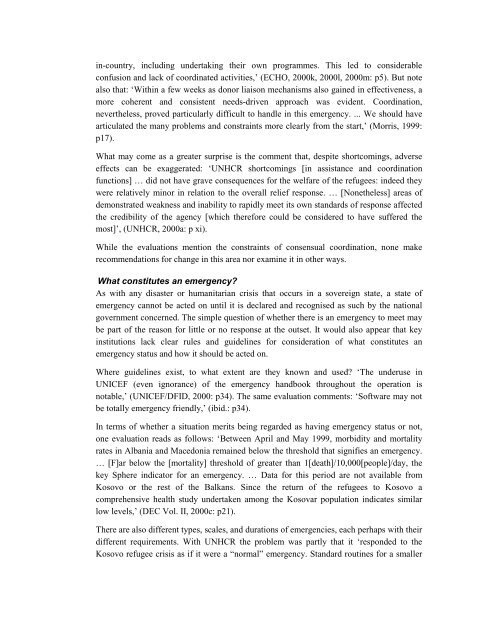Download PDF - ReliefWeb
Download PDF - ReliefWeb
Download PDF - ReliefWeb
Create successful ePaper yourself
Turn your PDF publications into a flip-book with our unique Google optimized e-Paper software.
in-country, including undertaking their own programmes. This led to considerable<br />
confusion and lack of coordinated activities,’ (ECHO, 2000k, 2000l, 2000m: p5). But note<br />
also that: ‘Within a few weeks as donor liaison mechanisms also gained in effectiveness, a<br />
more coherent and consistent needs-driven approach was evident. Coordination,<br />
nevertheless, proved particularly difficult to handle in this emergency. ... We should have<br />
articulated the many problems and constraints more clearly from the start,’ (Morris, 1999:<br />
p17).<br />
What may come as a greater surprise is the comment that, despite shortcomings, adverse<br />
effects can be exaggerated: ‘UNHCR shortcomings [in assistance and coordination<br />
functions] … did not have grave consequences for the welfare of the refugees: indeed they<br />
were relatively minor in relation to the overall relief response. … [Nonetheless] areas of<br />
demonstrated weakness and inability to rapidly meet its own standards of response affected<br />
the credibility of the agency [which therefore could be considered to have suffered the<br />
most]’, (UNHCR, 2000a: p xi).<br />
While the evaluations mention the constraints of consensual coordination, none make<br />
recommendations for change in this area nor examine it in other ways.<br />
What constitutes an emergency?<br />
As with any disaster or humanitarian crisis that occurs in a sovereign state, a state of<br />
emergency cannot be acted on until it is declared and recognised as such by the national<br />
government concerned. The simple question of whether there is an emergency to meet may<br />
be part of the reason for little or no response at the outset. It would also appear that key<br />
institutions lack clear rules and guidelines for consideration of what constitutes an<br />
emergency status and how it should be acted on.<br />
Where guidelines exist, to what extent are they known and used? ‘The underuse in<br />
UNICEF (even ignorance) of the emergency handbook throughout the operation is<br />
notable,’ (UNICEF/DFID, 2000: p34). The same evaluation comments: ‘Software may not<br />
be totally emergency friendly,’ (ibid.: p34).<br />
In terms of whether a situation merits being regarded as having emergency status or not,<br />
one evaluation reads as follows: ‘Between April and May 1999, morbidity and mortality<br />
rates in Albania and Macedonia remained below the threshold that signifies an emergency.<br />
… [F]ar below the [mortality] threshold of greater than 1[death]/10,000[people]/day, the<br />
key Sphere indicator for an emergency. … Data for this period are not available from<br />
Kosovo or the rest of the Balkans. Since the return of the refugees to Kosovo a<br />
comprehensive health study undertaken among the Kosovar population indicates similar<br />
low levels,’ (DEC Vol. II, 2000c: p21).<br />
There are also different types, scales, and durations of emergencies, each perhaps with their<br />
different requirements. With UNHCR the problem was partly that it ‘responded to the<br />
Kosovo refugee crisis as if it were a “normal” emergency. Standard routines for a smaller
















![CynefinFramework final [Read-Only]](https://img.yumpu.com/19017304/1/190x135/cynefinframework-final-read-only.jpg?quality=85)